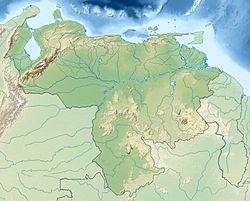The Chimantá Massif is a highly fragmented complex of tepuis in Bolívar state, Venezuela. The massif comprises around 11 tepuis[2] and has a total summit area of 615 km2 (237 sq mi) and an estimated slope area of 915 km2 (353 sq mi).[3] It is divided in two by the Río Tírica, with the northern section being both larger and higher. The massif is notable for its high species richness and for its varied habitat types.[3] It reaches an elevation of 2,698 metres (8,852 ft)[1] on its highest peak, Murey-tepui (also known as Eruoda-tepui).[3] The massif is situated entirely within the bounds of Canaima National Park.[4] It hosts extensive cave systems, including the world's largest known quartzite cave, Cueva Charles Brewer, named after discoverer Charles Brewer-Carías.[5][6][7] The processes behind their speleogenesis are the subject of some debate.[8][9][10]
Quick Facts Highest point, Elevation ...
Close
The isolated southern peaks of Angasima-tepui and Upuigma-tepui are sometimes considered part of the Chimantá Massif.[4][11]
The major tepuis of the northern and southern parts of the Chimantá Massif are listed below. Coordinates given correspond to the approximate centre points of the tepui summit plateaus. Unless otherwise indicated, all information in the tables is sourced from Flora of the Venezuelan Guayana.[3]
Northern group
More information Name, Coordinates ...
| Name | Coordinates | Maximum elevation | Summit area |
|---|
| Abacapá-tepui | 05°11′04″N 62°17′51″W | 2,400 m (7,900 ft) | 28.13 km2 (10.86 sq mi) |
| Agparamán-tepui | 05°14′50″N 62°12′29″W | 2,400 m (7,900 ft) | 22.5 km2 (8.7 sq mi) |
| Apacará-tepui | 05°19′12″N 62°13′43″W | 2,450 m (8,040 ft) | 173.12 km2 (66.84 sq mi) |
| Chimantá-tepui | 05°16′37″N 62°07′52″W | 2,550 m (8,370 ft) | 93.75 km2 (36.20 sq mi) |
| Murey-tepui | 05°22′36″N 62°05′36″W | 2,698 m (8,852 ft)[1] | 51.25 km2 (19.79 sq mi) |
| Tirepón-tepui | 05°22′04″N 62°01′12″W | ±2,600 m (8,500 ft) | 8.75 km2 (3.38 sq mi) |
| Toronó-tepui | 05°12′42″N 62°10′33″W | 2,500 m (8,200 ft) | 59.38 km2 (22.93 sq mi) |
Close
An additional plateau, Sarvén-tepui, may be distinguished to the east of Chimantá-tepui (05°17′55″N 62°04′17″W).[3]
Southern group
More information Name, Coordinates ...
Close
Nogué, S., V. Rull, E. Montoya, O. Huber & T. Vegas-Vilarrúbia (October 2009). Paleoecology of the Guayana Highlands (northern South America): Holocene pollen record from the Eruoda-tepui, in the Chimantá massif. Palaeogeography, Palaeoclimatology, Palaeoecology 281(1–2): 165–173. doi:10.1016/j.palaeo.2009.07.019 Briceño, H., C. Schubert & J. Paolini (1990). Table-mountain geology and surficial geochemistry: Chimantá Massif, Venezuelan Guayana Shield. Journal of South American Earth Sciences 3(4): 179–194. doi:10.1016/0895-9811(90)90002-I Aubrecht, R., C. Brewer-Carías, B. Šmída, M. Audy & Ľ. Kováčik (30 January 2008). Anatomy of biologically mediated opal speleothems in the world's largest sandstone cave: Cueva Charles Brewer, Chimantá Plateau, Venezuela. Sedimentary Geology 203(3–4): 181–195. doi:10.1016/j.sedgeo.2007.10.005 Aubrecht, R., T. Lánczos, M. Gregor, J. Schlögl, B. Šmída, P. Liščák, C. Brewer-Carías & L. Vlček (15 September 2011). Sandstone caves on Venezuelan tepuis: return to pseudokarst? Geomorphology 132(3–4): 351–365. doi:10.1016/j.geomorph.2011.05.023 Sauro, F., L. Piccini, M. Mecchia & J. De Waele (2013). Comment on "Sandstone caves on Venezuelan tepuis: return to pseudokarst?" by R. Aubrecht, T. Lánczos, M. Gregor, J. Schlögl, B. Smída, P. Liscák, Ch. Brewer-Carías, L. Vlcek, Geomorphology 132 (2011), 351–365. Geomorphology, published online on 29 November 2012. doi:10.1016/j.geomorph.2012.11.015 Aubrecht, R., T. Lánczos, M. Gregor, J. Schlögl, B. Šmída, P. Liščák, C. Brewer-Carías & L. Vlček (2013). Reply to the comment on "Sandstone caves on Venezuelan tepuis: return to pseudokarst?". Geomorphology, published online on 30 November 2012. doi:10.1016/j.geomorph.2012.11.017
- Barrio-Amorós, C.L., J. Mesa, C. Brewer-Carías & R.W. McDiarmid (25 May 2010). A new Pristimantis (Anura, Terrarana, Strabomantidae) from Churi-tepui in the Chimanta Massif, Venezuelan Guayana. Zootaxa 2483: 35–44.
- (in Spanish) Delascio-Chitty, F. & C. Brewer–Carías (February 2006). Notas florísticas del Churi–tepuy, Estado Bolívar, Venezuela. [Floristic notes of the Churí-tepuy, State of Bolívar, Venezuela.] In: I Congreso Internacional de Biodiversidad del Escudo Guayanés: Programa y Libro de Resúmenes.[permanent dead link] Universidad Nacional Experimental de Guayana, Puerto Ordaz. p. 141.
- Derka, T. & P. Fedor (21 October 2010). Hydrolutos breweri sp. n., a new aquatic Lutosini species (Orthoptera: Anostostomatidae) from Churí-tepui (Chimantá Massif, Venezuela). Zootaxa 2653: 51–59.
- Jaffe, K., J. Lattke & R. Perez-Hernández (January–June 1993). Ants on the tepuies of the Guiana Shield: a zoogeographic study. Ecotropicos 6(1): 21–28.
- (in Spanish) Huber, O. (ed.) (1992). El Macizo del Chimantá, Escudo de Guayana, Venezuela. Un ensayo ecológico tepuyano. Oscar Todtmann Editores, Caracas. ISBN 980-6028-16-3
- Kodada, J., T. Derka & F. Čiampor, Jr. (6 March 2012). Description of Jolyelmis spangleri a new species from Churí-tepui (Chimantá Massif, Venezuela), with a description of the larva of J. spangleri and J. reitmaieri (Insecta: Coleoptera: Elmidae). Zootaxa 3223: 1–23.
- Kok, P.J.R., R.D. MacCulloch, D.B. Means, K. Roelants, I. Van Bocxlaer & F. Bossuyt (7 August 2012). "Low genetic diversity in tepui summit vertebrates" (PDF). Archived from the original (PDF) on 2013-06-05. Retrieved 2013-03-07. Current Biology 22(15): R589–R590. doi:10.1016/j.cub.2012.06.034 "supplementary information" (PDF).[permanent dead link]
- (in Spanish) La Cruz, L. (February–April 2010). Iván Calderon y su mundo vertical. Río Verde 1: 98–115.
